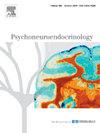急性最大运动量对 MDD 成人血清胰岛素样生长因子-1 的影响
IF 3.4
2区 医学
Q2 ENDOCRINOLOGY & METABOLISM
引用次数: 0
摘要
运动对情绪有急性和积极的影响,如果定期重复运动,可产生长期的抗抑郁效果。运动训练抗抑郁作用的机制尚不清楚,因此限制了运动训练治疗抑郁症的处方。重度抑郁症(MDD)患者的血清胰岛素样生长因子-1(IGF-1)似乎失调,这表明MDD可能会抑制或改变IGF-1对运动的反应。在健康人中,运动可使血清 IGF-1 急性升高,这可能会对 MDD 中失调的 IGF-1 系统产生积极作用。因此,本研究的目的是检测患有 MDD 的成人和健康对照组的血清 IGF-1 水平对急性最大运动量的敏感性。此外,多发性硬化症的临床和行为因素也可能会影响这一系统,如抑郁症的严重程度、抗抑郁药的使用和体育锻炼习惯等。基线数据来自德国的一项大型试验(SPeED 研究),收集对象为轻度至中度 MDD 患者(人数为 113 人)和健康对照组(人数为 34 人),他们的年龄、性别和教育程度相匹配。研究人员收集了人口统计学资料、抑郁症严重程度(汉密尔顿抑郁评分量表-17)、自我报告的抗抑郁药使用情况、MVPA(国际体力活动问卷-简表)以及最大运动量测试前后的抽血结果。研究人员进行了多元线性回归,以确定抑郁严重程度、抗抑郁药使用情况和体力活动与急性运动后外周 IGF-1 水平之间的关系。协变量包括人口统计学因素和运动前 IGF-1(基线水平)。抑郁症患者(平均 ± SD;11.3 ± 12.9)和健康成人(11.3 ± 20.4:p>0.05)的急性 IGF-1 变化相似。抑郁症的严重程度、抗抑郁药的使用和定期的体育锻炼都不能显著预测基线或运动后的外周 IGF-1 水平。无论临床和行为差异如何,患有多发性抑郁症的人都有可能在运动诱导下产生有利的IGF-1变化。急性运动会短暂增加外周 IGF-1,随着时间的推移,IGF-1 系统会逐渐恢复正常。IGF-1系统的正常化可能是运动时情绪升高的一个潜在机制,因此需要进行运动训练研究。本文章由计算机程序翻译,如有差异,请以英文原文为准。
Effects of an acute maximal exercise bout on serum insulin-like growth factor-1 in adults with MDD
Exercise has acute, positive effects on mood and can lead to antidepressant effects over time when repeated regularly. The mechanisms underlying the antidepressant effects of exercise training are not well known, limiting the prescription of exercise training for depression. Serum Insulin-Like Growth Factor-1 (IGF-1) appears dysregulated in those with Major Depressive Disorder (MDD), suggesting MDD could inhibit or alter the IGF-1 response to exercise. In healthy individuals, exercise has been shown to acutely increase serum IGF-1, which may act positively on the dysregulated IGF-1 system in MDD. Therefore, the purpose of this study was to examine the sensitivity of serum IGF-1 levels to an acute maximal exercise bout in adults with MDD and healthy controls. Additionally, clinical and behavioral factors of MDD are likely to affect this system, such as depression severity, antidepressant usage and physical activity habits. Baseline data were used from a larger trial in Germany (SPeED Study) collected from individuals with mild to moderate MDD (n=113) and healthy controls (n=34) that were matched for age, sex, and education. Demographics, depression severity (Hamilton Depression Rating Scale-17), self-reported antidepressant usage, MVPA (International Physical Activity Questionnaire-Short Form), and blood draws before and after a maximal exercise test were collected. Multiple linear regressions were conducted to determine relationships between depression severity, antidepressant usage, and physical activity with peripheral IGF-1 levels following acute exercise. Covariates included demographic factors and IGF-1 pre-exercise (baseline levels). Acute IGF-1 changes occurred similarly in depression (mean ± SD; 11.3 ± 12.9) as well as healthy adults (11.3 ± 20.4: p>0.05). Neither depression severity, antidepressant use, nor regular physical activity were significant predictors of peripheral IGF-1 levels at baseline or following exercise. Individuals with MDD are likely to have favorable exercise-induced IGF-1 changes regardless of clinical and behavioral differences. Acute exercise increases peripheral IGF-1 briefly, and in response to repeated exercise bouts, the IGF-1 system could normalize over time. The normalization of the IGF-1 system might be a possible mechanism underlying mood increases that occur during exercise with exercise training research warranted.
求助全文
通过发布文献求助,成功后即可免费获取论文全文。
去求助
来源期刊

Psychoneuroendocrinology
医学-精神病学
CiteScore
7.40
自引率
8.10%
发文量
268
审稿时长
66 days
期刊介绍:
Psychoneuroendocrinology publishes papers dealing with the interrelated disciplines of psychology, neurobiology, endocrinology, immunology, neurology, and psychiatry, with an emphasis on multidisciplinary studies aiming at integrating these disciplines in terms of either basic research or clinical implications. One of the main goals is to understand how a variety of psychobiological factors interact in the expression of the stress response as it relates to the development and/or maintenance of neuropsychiatric illnesses.
 求助内容:
求助内容: 应助结果提醒方式:
应助结果提醒方式:


